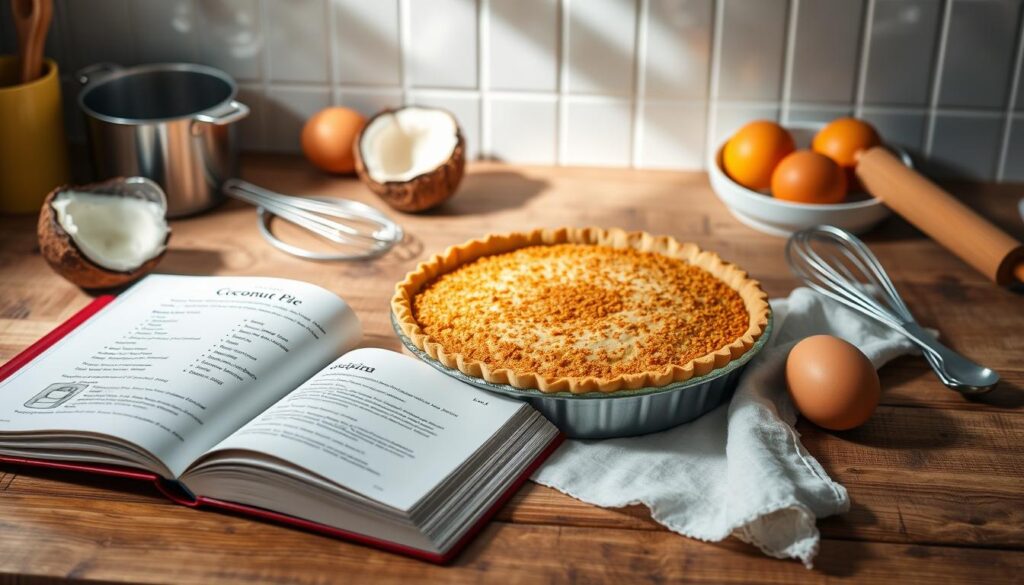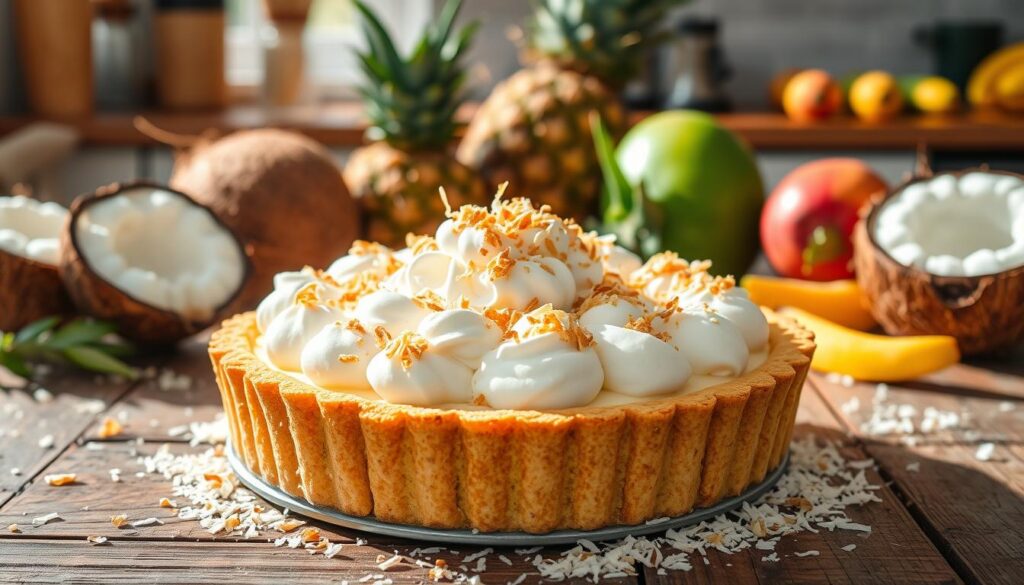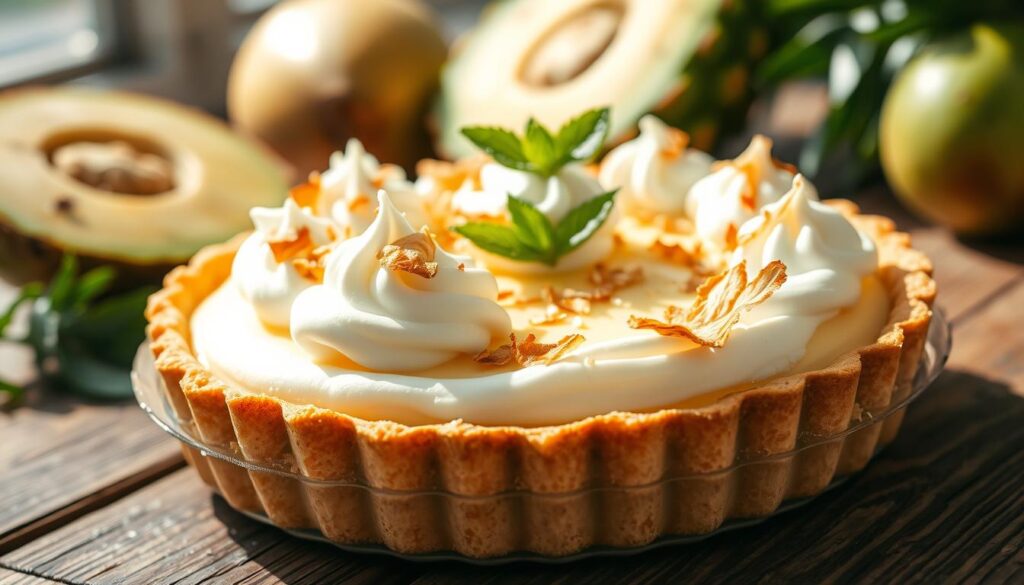Discover the delightful flavors of this coconut custard pie recipe, a simple yet decadent tropical dessert.
Table of Contents
The coconut cream pie is a classic tropical dessert that never fails to impress with its rich flavors and creamy texture. As a popular easy pie recipe, it has become a staple in many households, perfect for special occasions or as a sweet treat any time of the year. With its unique blend of coconut and custard, this tropical dessert is sure to transport your taste buds to a paradise of flavors.
As a versatile and delicious dessert, the coconut custard pie is an excellent choice for anyone looking to try a new easy pie recipe. Whether you’re a fan of coconut cream pie or just looking to explore the world of tropical desserts, this recipe is sure to satisfy your cravings and leave you wanting more. With its simple ingredients and straightforward instructions, this easy pie recipe is perfect for bakers of all skill levels, making it an ideal choice for anyone looking to create a sweet and delicious tropical dessert.
The History of Coconut Custard Pie
Coconut custard pie has a rich history that dates back to colonial America, where coconut was a staple ingredient in many desserts. The coconut custard filling was a key component of this pie, made with fresh coconut, sugar, eggs, and spices. Over time, the recipe evolved, and new baking techniques were introduced, allowing for a flakier pie crust recipe and a creamier coconut custard filling.
The evolution of the recipe was influenced by various cultural and social factors, including the availability of ingredients and the exchange of ideas between different colonies. As a result, the coconut custard pie became a beloved dessert throughout America, with each region adding its own unique twist to the original recipe.
Origins in Colonial America
In colonial America, coconut was a rare and expensive ingredient, making it a luxury item for special occasions. The first coconut custard pies were made with a simple pie crust recipe and a coconut custard filling made with fresh coconut, sugar, and eggs.
Evolution of the Recipe
As trade and commerce expanded, new ingredients and baking techniques became available, allowing for the development of more complex and sophisticated recipes. The introduction of new spices, such as nutmeg and cinnamon, added depth and warmth to the coconut custard filling, while the use of different types of sugar and cream enhanced the texture and flavor of the filling.
Cultural Significance
Today, coconut custard pie is a beloved dessert throughout America, with a rich cultural significance that reflects the country’s history and diversity. The pie is often served at family gatherings and special occasions, and its unique flavor and texture have made it a staple of American cuisine.
| Ingredient | Quantity |
|---|---|
| Coconut | 1 cup |
| Sugar | 1 cup |
| Eggs | 2 |
| Spices | 1 tsp |
Essential Ingredients for the Perfect Coconut Custard Pie Recipe
To create a delicious coconut custard pie, it’s crucial to use high-quality ingredients that complement the tropical flavors of coconut. One of the key ingredients is coconut milk, which adds a rich and creamy texture to the pie. When selecting coconut milk, choose a full-fat version for the best flavor and texture.
Other essential ingredients include eggs, sugar, and a touch of salt. For a unique twist on traditional dessert ideas, consider adding a splash of vanilla extract or a pinch of nutmeg to the filling. The combination of these ingredients will result in a pie that’s both familiar and excitingly new, perfect for those looking to try new tropical flavors.
- 1 cup of coconut milk
- 2 large eggs
- 1/2 cup of granulated sugar
- 1/4 teaspoon of salt
- 1/2 teaspoon of vanilla extract (optional)
These ingredients will help you create a coconut custard pie that’s sure to impress your friends and family with its rich, tropical flavors and creamy texture, making it a great addition to any dessert ideas collection.
Kitchen Tools and Equipment Needed
To make a delicious coconut custard pie, it’s essential to have the right kitchen tools and equipment. This includes basic baking supplies such as a mixing bowl, whisk, and rubber spatula. Having these essentials within reach will make the baking process more efficient and enjoyable.
In addition to the basics, there are several kitchen gadgets that can make the process easier. A stand mixer, for example, can be used to cream together the butter and sugar, while a food processor can be used to chop the coconut. These gadgets can save time and effort, allowing you to focus on the more enjoyable aspects of baking.
When it comes to measuring ingredients, accuracy is crucial. Measuring cups and spoons are must-haves in any baker’s kitchen. It’s also a good idea to have a digital scale on hand, as this can provide even more precise measurements. By having the right tools and equipment, you’ll be well on your way to creating a delicious coconut custard pie.
- A pastry brush for egg wash
- A rolling pin for rolling out the crust
- A pie dish for baking the pie
By investing in these tools and equipment, you’ll be able to create a wide range of delicious baked goods, including the perfect coconut custard pie.
Preparing Your Pie Crust
To create a delicious coconut custard pie, it’s essential to start with a well-made pie crust recipe. This involves making a simple pastry dough using flour, butter, and water. The key to a flaky crust is to keep the ingredients cold and handle the dough gently.
When making the pie crust recipe, it’s crucial to use the right baking techniques. This includes rolling out the dough to the correct thickness and placing it in the pie dish without stretching it. A well-made crust will help the pie hold its shape and prevent it from becoming too runny.
- Use cold ingredients to prevent the butter from melting
- Handle the dough gently to avoid developing the gluten
- Roll out the dough to the correct thickness to prevent it from becoming too thick or too thin
By following these tips and using the rightbaking techniques, you’ll be able to create a deliciouspie crustthat will complement your coconut custard filling perfectly. Remember to keep yourpastry doughcold and handle it gently to ensure a flaky and tender crust.
Making the Coconut Custard Filling
To create a delicious coconut custard filling, start by mixing the base ingredients, including eggs, sugar, and milk. This mixture is the foundation of the filling and provides the necessary structure and sweetness. When making the coconut custard filling, it’s essential to use high-quality ingredients to ensure the best flavor and texture.
The next step is to add the coconut, which gives the filling its unique tropical flavors. You can use shredded or flaked coconut, depending on your preference. The coconut adds a rich, creamy texture to the filling and complements the other ingredients perfectly. For a variation on traditional dessert recipes, consider adding a hint of vanilla or lime zest to the filling.
- Use room temperature ingredients to ensure a smooth mixture.
- Don’t overmix the filling, as this can cause it to become too thick.
- Adjust the amount of milk or cream to achieve the desired consistency.
By following these tips and using the right ingredients, you can create a delicious coconut custard filling that’s perfect for a variety of dessert recipes. The tropical flavors of the coconut and the creamy texture of the filling make it an ideal choice for pies, tarts, and other sweet treats.
| Ingredient | Quantity |
|---|---|
| Eggs | 3 |
| Sugar | 1 cup |
| Milk | 1 cup |
| Coconut | 1 cup |
Baking Techniques and Temperature Guidelines
To achieve the perfect coconut custard pie, it’s essential to master various baking techniques and understand the importance of temperature control. Pie baking requires precision, as the filling and crust must be cooked to the right consistency without overcooking or undercooking.
Some key baking techniques to keep in mind include rotating the pie halfway through the baking time to ensure even cooking, and using a water bath to prevent the crust from burning. Additionally, it’s crucial to monitor the pie’s temperature, as this will affect the final texture and consistency of the filling.
Here are some general guidelines for temperature control in pie baking:
- Preheat the oven to 375°F (190°C) for a standard pie crust
- Use a thermometer to ensure the filling reaches a temperature of 170°F (77°C) to 180°F (82°C)
- Avoid overbaking, as this can cause the filling to become too firm or the crust to become too dark
By following these guidelines and mastering the art of temperature control and baking techniques, you’ll be well on your way to creating a delicious and perfectly baked coconut custard pie.

Remember, practice makes perfect, so don’t be discouraged if your first attempts at pie baking don’t turn out as expected. With time and patience, you’ll develop the skills and techniques needed to create a truly exceptional coconut custard pie.
| Baking Technique | Temperature | Time |
|---|---|---|
| Preheating | 375°F (190°C) | 10-15 minutes |
| Baking | 170°F (77°C) to 180°F (82°C) | 40-50 minutes |
How to Tell When Your Pie Is Done
Determining the perfect pie doneness is crucial for a delicious dessert. When it comes to baking tips, checking the pie’s consistency and appearance can make all the difference. For dessert recipes like coconut custard pie, it’s essential to balance the filling’s texture and the crust’s golden brown color.
To achieve the ideal pie doneness, look for visual indicators such as a golden brown crust and a set filling. You can also use testing methods like inserting a knife or toothpick into the center of the pie. If it comes out clean, the pie is done. Another way to check is by gently jiggling the pie; if the filling is set, it should not wobble excessively.
Common Mistakes to Avoid
- Overbaking, which can cause the crust to become too dark and the filling to dry out
- Underbaking, resulting in a runny filling and a pale crust
- Not letting the pie cool completely, which can affect its texture and stability
By following these baking tips and being mindful of common mistakes, you can ensure your coconut custard pie turns out perfectly. Remember to always check the pie’s doneness regularly during the baking process, and don’t be afraid to experiment with different dessert recipes to find your favorite.
Testing Methods
In addition to visual indicators, you can use various testing methods to determine the pie’s doneness. These include checking the internal temperature, using a food thermometer, or inserting a toothpick into the filling. By combining these methods, you can ensure your pie is perfectly baked and ready to be enjoyed.
| Testing Method | Description |
|---|---|
| Visual Inspection | Check the crust’s color and the filling’s texture |
| Toothpick Test | Insert a toothpick into the filling; if it comes out clean, the pie is done |
| Internal Temperature | Use a food thermometer to check the internal temperature of the filling |
Cooling and Storage Tips
After baking, it’s essential to cool the coconut custard pie properly to prevent cracking and ensure a smooth texture. This involves using effective cooling techniques, such as placing the pie on a wire rack to allow air to circulate underneath. Proper cooling methods are crucial for dessert preservation, as they help prevent the growth of bacteria and other microorganisms that can cause spoilage.
When it comes to pie storage, it’s vital to keep the pie in an airtight container to maintain its freshness. The storage duration will depend on various factors, including the storage conditions and the type of pie. Generally, a coconut custard pie can be stored in the refrigerator for up to 3 days. For longer-term storage, freezing is a great option. Freezing instructions typically involve wrapping the pie tightly in plastic wrap or aluminum foil and placing it in a freezer-safe bag.
Proper Cooling Methods
- Place the pie on a wire rack to allow air to circulate underneath
- Let the pie cool to room temperature before refrigerating or freezing
- Avoid cooling the pie in a drafty area, as this can cause the filling to become uneven
Storage Duration
The storage duration of a coconut custard pie will depend on various factors, including the storage conditions and the type of pie. Generally, a coconut custard pie can be stored in the refrigerator for up to 3 days.
Freezing Instructions
For longer-term storage, freezing is a great option. Freezing instructions typically involve wrapping the pie tightly in plastic wrap or aluminum foil and placing it in a freezer-safe bag. When you’re ready to serve, simply thaw the pie overnight in the refrigerator and serve chilled.
Delicious Variations and Additions
When it comes to dessert variations, coconut cream pie is a versatile treat that can be modified to suit any taste. One way to add a twist to this classic dessert is by incorporating tropical flavors, such as mango or pineapple, into the filling. This can be done by mixing in fresh fruit puree or using tropical-flavored extracts.
Another way to enhance the flavor of coconut cream pie is by adding different mix-ins, such as toasted nuts or shredded coconut. These additions can provide a nice texture contrast and add depth to the overall flavor of the pie. For those looking to try something new, coconut cream pie can also be paired with other desserts, such as chocolate sauce or caramel, to create a unique and delicious treat.
Some popular dessert variations include:
- Mango coconut cream pie, featuring a mango-infused filling and toasted coconut flakes
- Pineapple upside-down coconut cream pie, with caramelized pineapple rings and a brown sugar crust
- Coconut cream pie with a macadamia nut crust, adding a rich and buttery flavor to the classic dessert
These are just a few examples of the many delicious variations and additions that can be made to coconut cream pie. With its rich and creamy texture, and the versatility of tropical flavors, this dessert is sure to be a hit with anyone who tries it.

| Variation | Description |
|---|---|
| Mango Coconut Cream Pie | A tropical twist on the classic dessert, featuring mango puree and toasted coconut flakes |
| Pineapple Upside-Down Coconut Cream Pie | A creative take on the classic pineapple upside-down cake, featuring caramelized pineapple rings and a brown sugar crust |
Serving Suggestions and Pairings
When it comes to serving coconut custard pie, the right dessert pairings can elevate the experience. Consider pairing the pie with a warm beverage, such as coffee or tea, for a cozy treat. For a more decadent experience, try pairing the pie with a rich, chocolate-based beverage pairing. The key to successful serving suggestions is to balance the flavors and textures of the pie with the accompanying elements.
Some popular serving suggestions include garnishing the pie with fresh fruit, such as raspberries or blueberries, or adding a sprinkle of powdered sugar. These garnish ideas can add a pop of color and freshness to the dish. Additionally, consider serving the pie at a comfortable temperature, as this can affect the texture and flavor of the custard. Temperature recommendations vary, but serving the pie at room temperature or slightly chilled is often preferred.
Here are some beverage accompaniments that pair well with coconut custard pie:
- Coffee: a classic pairing that complements the richness of the custard
- Tea: a soothing and calming pairing that pairs well with the sweetness of the pie
- Hot chocolate: a decadent and rich pairing that is perfect for special occasions
In terms of dessert pairings, consider pairing the coconut custard pie with other sweet treats, such as ice cream or whipped cream. These pairings can add a fun and playful touch to the dish. Ultimately, the key to successful serving suggestions is to experiment and find the combinations that work best for you and your guests.
| Beverage | Pairing Suggestions |
|---|---|
| Coffee | Pair with a slice of coconut custard pie for a classic breakfast or brunch treat |
| Tea | Pair with a slice of coconut custard pie for a soothing and calming afternoon treat |
| Hot Chocolate | Pair with a slice of coconut custard pie for a decadent and rich dessert treat |
Troubleshooting Common Issues
When making a coconut custard pie, pie troubleshooting is essential to ensure the dessert turns out perfectly. Common baking mistakes can lead to a range of dessert problems, from a burnt crust to a custard that’s too runny. To avoid these issues, it’s crucial to understand the common pitfalls and how to fix them.
A few common problems that may arise during the baking process include:
- Overmixing the filling, leading to a tough custard
- Not baking the crust long enough, resulting in a soggy bottom
- Not cooling the pie properly, causing the custard to weep or become too runny
To resolve these pie troubleshooting issues, try the following:
- Mix the filling ingredients just until they’re combined, being careful not to overmix
- Bake the crust for the recommended amount of time, or until it’s golden brown
- Cool the pie slowly and carefully, allowing it to come to room temperature before refrigerating
By following these tips and being mindful of common baking mistakes, you can avoid dessert problems and create a delicious coconut custard pie that’s sure to impress.
Conclusion
In conclusion, the coconut custard pie recipe is a true delight, offering a sweet and tropical treat that transports the taste buds to a sun-drenched island paradise. This versatile dessert has evolved over the centuries, becoming a beloved staple in many households and a cherished part of cultural traditions.
Whether you’re a seasoned baker or a novice in the kitchen, mastering the art of the coconut custard pie is an achievable goal. With the right ingredients, tools, and techniques, you can create a showstopping dessert that will impress your friends and family. So, don’t be afraid to experiment and put your own unique twist on this timeless tropical dessert.
As you continue on your baking journey, remember to have fun, embrace the process, and savor the delicious rewards of your labor. The easy pie recipe shared in this article is just the beginning of your coconut custard pie adventures. Enjoy the journey, and let the flavors of the tropics transport you to a world of pure bliss.



